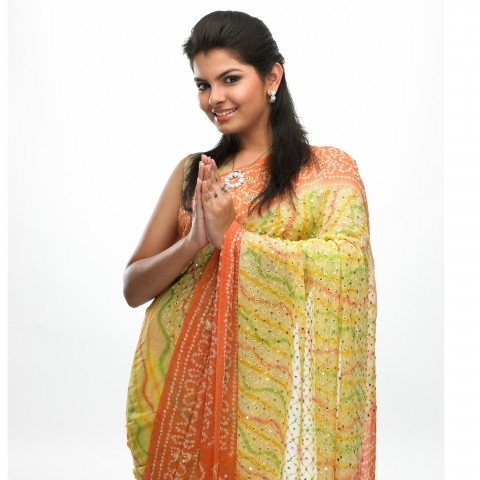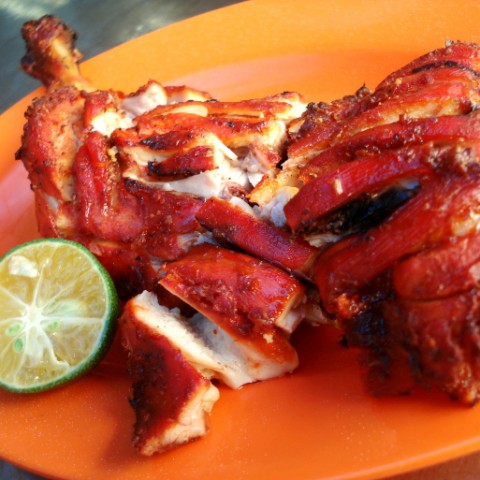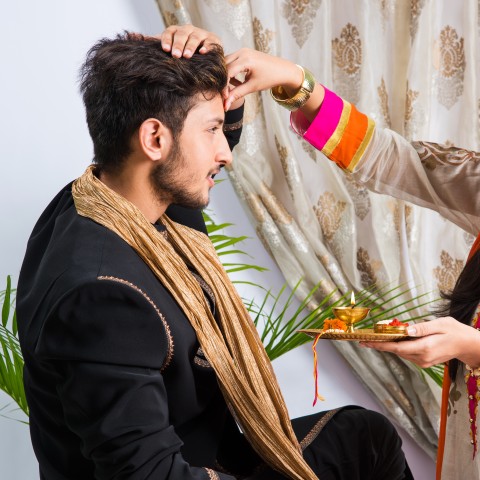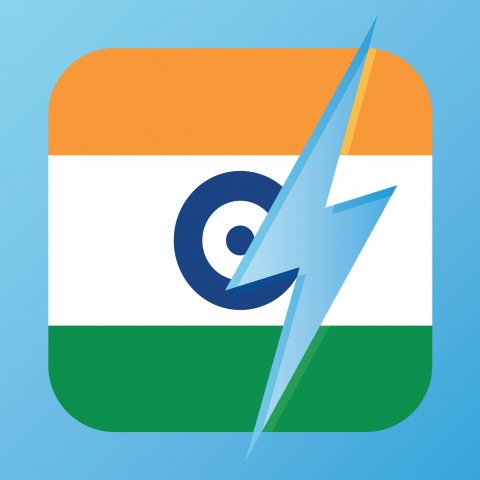
In India, people love to socialize. A smile comes in handy and folks don’t mind initiating the conversation and asking your whereabouts. In short, expect a heartwarming welcome if you’re coming to India, and even more so if it’s your first time here. Hindi is a widely spoken language in India and all over the world. In India, using phrases like “I live in..” or “My name is..” in Hindi, can be a real-quick ice-breaker in the first meeting.
Whether you’re here to attend a party or a job interview, or you’re on a business trip, a bare minimum knowledge of Hindi helps you easily gel with others while feeling more connected to the conversation. Being a non-Hindi person, you may wonder how to introduce yourself in Hindi. Worry not! HindiPod101 has got you covered. Initially, just knowing some common Hindi phrases is enough to get you going for a while.
So, what are you waiting for? Let’s learn some basics about introducing yourself in Hindi. Following are some examples of how to introduce yourself in Hindi, so let’s get on with our dictionary and information on how to introduce yourself in Hindi, with translations.
Table of Contents
- Some Basic Etiquette Tips
- Greeting Others
- How to Talk About Yourself
- How to Talk about Nationality!
- Handling a Personal Talk!
- About Your Profession and Other Details!
- Speak Flawless Hindi with HindiPod101
1. Some Basic Etiquette Tips
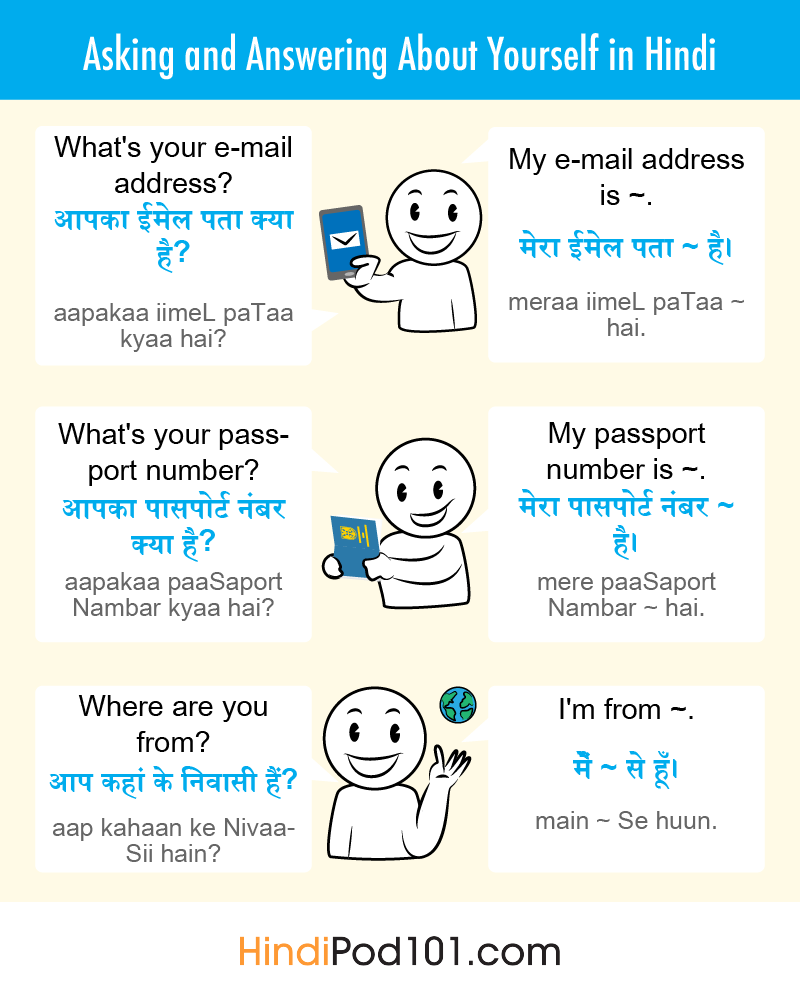
It makes sense to do a little homework before traveling to a new country. Check out these Ten Quick Facts about Hindi to stay ahead. You can also learn more about the Do’s and Don’ts that apply to the Indian culture. Unlike in English, there are separate words for addressing someone, based on their age and other factors.
1- Using the Formal Version of “You”
Whether it’s a formal occasion or an informal one, if you’re about to give your introduction in Hindi, use the word आप (aap) meaning “You” for women and people who are senior to you. In a business meeting or any other formal get-together, it’s better to address your co-workers by the word आप (aap) which is a more formal version of “You.” As the Indian society is becoming more sophisticated with time, people also prefer to address children in the same way.
For more information, you can get as many details as you like about the Hindi language.
2- The Body Language
Indians are sensitive when it comes to body language. Staying too close to a female, touching the other females while talking casually, might make the local folks a little uncomfortable. Even if you’re there with your spouse or partner, PDA is still not that common around here. However, these rules aren’t followed very strictly anymore. From the cultural point of view, the society—especially the younger generation—is opening up really fast.
2. Greeting Others
Curious about pronouncing Hindi words correctly? Sharpen your skills on our Hindi Pronunciation page.
Another way to conversate gracefully is by using the word आप (aap) or “You.” आप (aap) is preferred over तुम (Tum) also meaning “you,” when meeting new people in India. This holds true while addressing the females and the elderly.
If you’re meeting the folks for the first time, the same goes for people who are either your age or younger. आप (aap) or “You” sounds better while talking to them. But it’s not just what you say out loud! Your body language speaks volumes about your enthusiasm.
A smiling face is a great way to tell people that you’re really enjoying their company. Leave an unforgettable impression on others by greeting them with a hand gesture of नमस्ते (NamaSTe) which means “Hello” in Hindi.
Cultural Tips:
- A language loses its spell if the right gestures are missing!
- So, the next time you’re in India, instead of “Hello” say नमस्ते (NamaSTe) which also means “Hello,” and wait for the magic to happen.
- If there’s one thing that melts the Indian heart within a minute, it’s a non-native person saying नमस्ते (NamaSTe) to them. This is the right way to introduce yourself in Hindi.
- Make sure to bring both of your hands forward and join the palms together, while tilting your head slightly forward.
- When you’re surrounded by a group of people your own age, a नमस्ते (NamaSTe) might be replaced by a warm handshake. This is more common among males.
3. How to Talk About Yourself
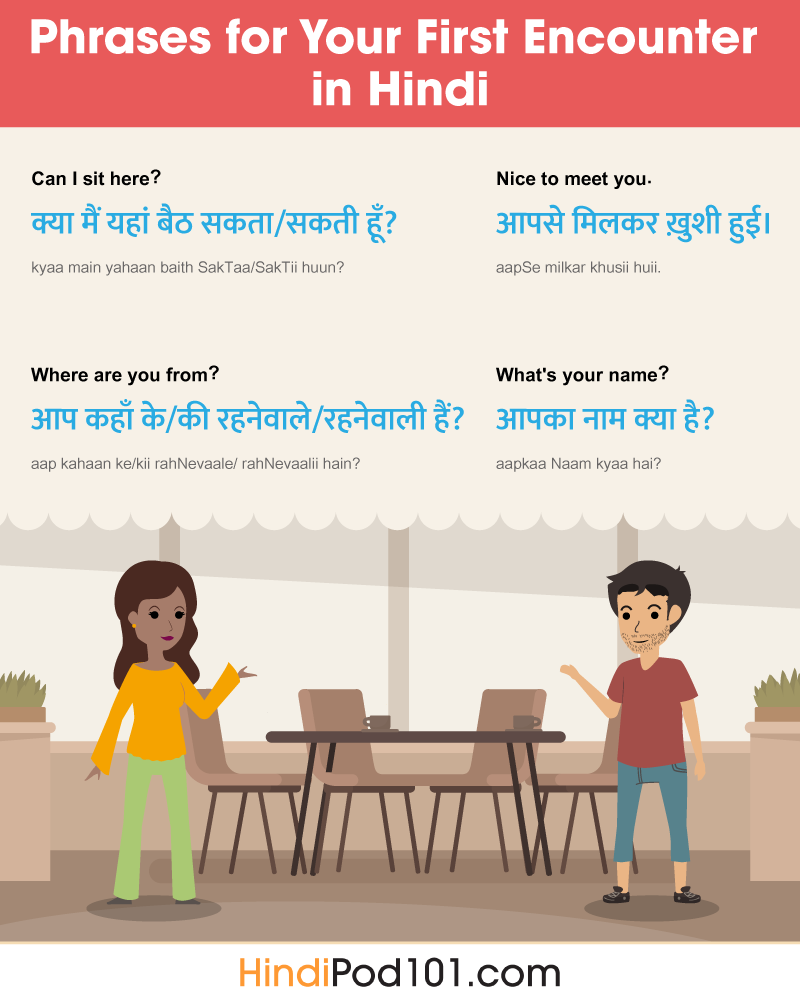
When you talk about yourself, keep in mind the “Gender Rules” described above. It’ll help you introduce yourself in Hindi with more confidence. Let’s look at some of the common self-introduction statements used in Hindi.
- “Hello, how are you?”
- नमस्ते, आप कैसे हैं? (NamaSTe, aap kaiSe haĩn?) [While talking to a male.]
- नमस्ते, आप कैसी हैं? (NamaSTe, aap kaiSii haĩn?) [While talking to a female.]
- “Hello” — नमस्ते (NamaSTe)
- “How” — कैसे/ कैसी (kaiSe / kaiSiii)
- “Are” — हैं (hain)
- “You” — आप (aap)
- “Yes, I am fine, thank you.”
- जी, मैं ठीक हूँ, धन्यवाद। (jii, main thiik huun, DHaNyavaaD.)
- “Yes” — जी (jii)
- “I” — मैं (main)
- “Am” — हूँ (huun)
- “Fine” — ठीक (thiik)
- “Thank you” — धन्यवाद (DHaNyavaaD)
- “My name is John.”
- मेरा नाम जॉन है।. (meraa Naam jauN hai.)
- “My” — मेरा (meraa)
- “Name” — नाम (Naam)
- “Is” — है (hai)
- “John” — जॉन (jauN)
- “Pleasure to meet you.”
- आप से मिलकर अच्छा लगा।. (aap Se miLakar acchaa Lagaa.)
- “Pleasure” — अच्छा लगा (acchaa Lagaa)
- “To” — से (Se)
- “Meet” — मिलकर (miLakar)
- “You” — आप (aap)
Talking about your name in Hindi is unavoidable! If you don’t know how to write your name in Hindi, ask our teachers on our Hindi Names page!
Cultural Tip:
- Your tone matters in India. Anything spoken in a soft tone is quite well-received.
- Moreover, people here don’t just listen to your voice but also read your body language. For example, if you’re bored or uninterested in the conversation, they can sense it real quick.
- If you’re sitting alone, they’ll notice it and give you company.
- They also make sure that you’re comfortable and not feeling left out!
4. How to Talk about Nationality!

Consider it as Level-II of “How to Introduce Yourself in Hindi.” After successfully crossing the initial greetings stage, the conversation may go on like this!
- “Where do you come from?”
- आप कहाँ से हैं? (aap kahaan Se hain?)
- “Where” — कहाँ (kahaan)
- “Are” — हैं (hain)
- “You” — आप (aap)
- “Come from” — से (Se)
- “I am from Japan.”
- मैं जापान से हूँ। (main jaapaaN Se huun.)
- “I” — मैं (main)
- “Am” — हूँ (huun)
- “From” — से (Se)
- “Japan” — जापान (jaapaaN)
Both of the above sentences are gender-neutral. This is the list of countries in the Hindi language.
Cultural Tip:
- India is a vast country and yet people have all sorts of curiosity and respect for other cultures around the world. This may pave a road for some common questions about your country, especially the staple foods and the weather in your country!
- When it comes to dressing up, wearing proper formal attire to the occasion is a good idea. Indians are more comfortable if the females are in a dress that covers their legs and shoulders properly.
- If you’ve never had an Indian meal before, your taste buds are going to explode. The food here is mostly spicy and hot. The cuisine is easier to eat with your hands instead of a knife and fork. Make sure that you use your right hand for eating. Avoid using the left hand at all costs! Also keep in mind that the sweets may taste too sweet to you, but you’re surely going to love it in the end. The food here is addictive!!
5. Handling a Personal Talk!
It’s common for the elders to ask you about your marital status and family. Knowing these sentences beforehand can turn out to be quite helpful while introducing yourself in Hindi. Talking about your family in Hindi is an important topic to have covered in your knowledge base!
- “Are you married?”
- क्या आप शादीशुदा हैं? (kyaa aap saaDiisuDaa hain?)
- “Are” — क्या (kyaa) and हैं (hain) [In the interrogative form, it stands for both kyaa and hain.)
- “You” — आप (aap)
- “Married” — शादीशुदा (saaDiisuDaa)
- “Yes, I am married.”
- जी हाँ, मैं शादीशुदा हूँ।. (jii haan, main saaDiisuDaa huun.)
- “Yes” — जी, हाँ (jii haan)
- “I” — मैं (main)
- “Am” — हूँ (huun)
- “Married” — शादीशुदा (saaDiisuDaa)
- “No, I am not married.”
- जी नहीं, मैं शादीशुदा नहीं हूँ। (jii Nahiin, main saaDiisuDaa Nahiin huun.)
- “No” — जी नहीं (jii nahiin)
- “I” — मैं (main)
- “Am” — हूँ (huun)
- “Not” — नहीं (Nahiinĩ)
- “Married” — शादीशुदा (saaDiisuDaa)
Cultural Tip:
- At first, the kind of questions asked in your first conversation in India may feel a bit intrusive to you. But worry not, it’s just a harmless way of ice-breaking in India!
- In India, they love to hear about your spouse and kids. Expect a few questions about your kids, their education, your spouse’s profession, etc.
- If you don’t have kids, they might even ask when you’re going to have one! Don’t be shocked! It’s almost out of love.
6. About Your Profession and Other Details!

Talking about your profession and hobbies in Hindi can really liven the discussion! Here are some phrases you should know.
- “Where do you live currently?”
- फ़िलहाल, आप कहाँ रहते/रहती हैं? (fiLahaaL, aap kahaan rahaTe/rahaTii hain?)
- “Where” — कहाँ (kahaan)
- “Do” — हैं (hain)
- “You” — आप (aap)
- “Live” — रहते/रहती (rahaTe/Tii)
- “Currently” — फ़िलहाल (fiLahaaL)
- “Currently, I am living in Delhi.”
- फ़िलहाल, मैं दिल्ली में रह रहा/रही हूँ। (fiLahaaL, main DiLLii men rah rahaa/rahii huun)
- “Currently” — फ़िलहाल (fiLahaaL)
- “I” — मैं (main)
- “Am” — हूँ (huun)
- “Living” — रह रहा/ रही (rah rahaa / rahii)
- “In” — में (men)
- “Delhi” — दिल्ली (DiLLii)
- “What do you do?”
- आप क्या करते/करती हैं? (aap kyaa karaTe / karaTii hain?)
- “What” — क्या (kyaa)
- “Do” — हैं (hain)
- “You” — आप (aap)
- “Do” — करते/करती (karaTe / karaTii)
- “I am a writer.”
- मैं एक लेखक/लेखिका हूँ।? (main ek Lekhak/Lekhikaa huun?)
- “I” — मैं (main)
- “Am” — हूँ (huun)
- “A” — एक (ek)
- “Writer” — लेखक/लेखिका (Lekhak / Lekhikaa)
- “How do you like to spend your free time?”
- आप अपना ख़ाली वक़्त कैसे बिताना पसंद करते/करती हैं? (aap apaNaa khaaLii vaqT kaiSe biTaaNaa paSaND karaTe / karaTii hain?)
- “How” — कैसे (kaiSe)
- “Do” — हैं (hain)
- “You” — आप (aap)
- “Like” — पसंद (paSaND)
- “To spend” — बिताना (biTaaNaa)
- “Your” — अपना (apaNaa)
- “Free” — ख़ाली (khaaLii)
- “Time” — वक़्त (vaqT)
- “I like to cook food in my free time.”
- मैं अपने ख़ाली वक़्त में खाना पकाना पसंद करता/करती हूँ. (main apaNe khaaLii vaqT men khaaNaa pakaaNaa paSaND karaTa/karaTii huun.)
- “I” — मैं (main)
- “Like” — पसंद (paSaND)
- “To cook” — पकाना (pakaaNaa)
- “Food” — खाना (khaaNaa)
- “In” — में (men)
- “My” — अपने (apaNe)
- “Free” — ख़ाली (khaaLii)
- “Time” — वक़्त (vaqT)
Cultural Tip:
- At some places, the guests are welcomed with a Tilak (“mark”) on the forehead made with a paste of red sandalwood. The sandalwood is imbibed with cooling properties and is believed to soothe the third eye. Females can also pamper their hands with intricate mehndi (“Henna”) designs.
- Unlike Church, visiting religious places here requires you to take off your shoes. (Just a gentle reminder!)
We hope you enjoyed this Hindi lesson! And if your thirst for learning is still unquenched, you’re most welcome to explore Hindi on a deeper level.
7. Speak Flawless Hindi with HindiPod101
There’s so much more on HindiPod101.com, a great website to make your Hindi learning fun and easy. Leave the hesitation behind and dive into the ocean of infotainment. On HindiPod101, you find everything that you need, from the amazing video classes to common Hindi key phrases.
What’s more! You also get access to free audio charts, free vocabulary lists, and a free Hindi dictionary. There are flash cards and PDF notes to ease things for you as well.
So, join us and have an amazing Hindi time with us on HindiPod101!
In the meantime, we hope you’ll practice introducing about yourself in the Hindi language using the examples we provided. Good luck!




